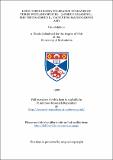Files in this item
Long-term anoxia tolerance in leaves of three wetland species : (Acorus calamus L., Iris pseudacorus L., Vaccinium macrocarpon AIT)
Item metadata
| dc.contributor.advisor | Crawford, R. M. M. | |
| dc.contributor.author | Schlüter, Urte | |
| dc.coverage.spatial | 162 p. | en_US |
| dc.date.accessioned | 2018-06-25T12:57:43Z | |
| dc.date.available | 2018-06-25T12:57:43Z | |
| dc.date.issued | 1999 | |
| dc.identifier.uri | https://hdl.handle.net/10023/14540 | |
| dc.description.abstract | Anoxia tolerance of Acorus calamus. Iris pseudacorus and Vaccinium macrocarpon has been investigated by incubating whole plants under anaerobic conditions in the dark. Long-term survival of rhizomes under anoxia has been described in previous studies, but this study has shown that green leaves can also endure anoxia for prolonged periods. Leaves of A. calamus, I.pseudacorus and V.macrocarpon remained green and turgid under anoxia for up to 75d, 60d and 45d respectively. All growth processes ceased in leaves under anoxia. Anaerobic energy production via ethanol fermentation was active in all investigated plant organs as shown by the accumulation of ethanol. Low rates of anaerobic CO2 production indicated however, that the overall metabolic activity in the leaves was low under prolonged anoxia. The leaves seemed to adapt to the anaerobic conditions by an overall reduction of energy consumption rather than acceleration of the glycolytic rate. The demands for fermentable substrate were met by the mobilisation of internal carbohydrate reserves in leaves of V.macrocarpon. A.calamus and I.pseudacorus leaves contained only small amounts of carbohydrates, and these leaves possibly received carbohydrates from the stores in the rhizome. Prolonged anoxia considerably affected the leaf capacity for respiration and photosynthesis. After 28d of anoxia, respiratory capacity was reduced in A.calamus and V.macrocarpon by 80%, and in I.pseudacorus by 90-95%; this corresponded with a decline in the activity of the cytochrome c oxidase. The photosynthetic capacity of leaves was decreased after 28d of anoxia by 83% in A.calamus, by 97% in I.pseudacorus and by 80% in V.macrocarpon. The reduction in the photosynthetic capacity was accompanied by alterations in the chlorophyll fluorescence pattern indicating damage to the PSII reaction centre and the subsequent electron transport; only minor changes occurred in the chlorophyll content of anaerobic leaves. On return to air and light, recovery of respiration and photosynthesis occurred in the leaves, but species-specific differences were observed in the speed of recovery. Among the three investigated species, A.calamus leaves endured the anoxic conditions longer than leaves of the other two species; and on return to air, A.calamus leaves showed the most rapid recovery. A.calamus was characterised by efficient carbohydrate utilisation under anoxia. Cellular membranes and organelle ultrastructure appeared to be stable in A.calamus leaves for at least 28d of anoxia. | en_US |
| dc.language.iso | en | en_US |
| dc.publisher | University of St Andrews | |
| dc.subject.lcc | QK938.M3S6 | en |
| dc.subject.lcsh | Wetland plants | en |
| dc.title | Long-term anoxia tolerance in leaves of three wetland species : (Acorus calamus L., Iris pseudacorus L., Vaccinium macrocarpon AIT) | en_US |
| dc.type | Thesis | en_US |
| dc.contributor.sponsor | University of St Andrews | en_US |
| dc.contributor.sponsor | Deutscher Akademischer Austauschdienst (DAAD) | en_US |
| dc.type.qualificationlevel | Doctoral | en_US |
| dc.type.qualificationname | PhD Doctor of Philosophy | en_US |
| dc.publisher.institution | The University of St Andrews | en_US |
This item appears in the following Collection(s)
Items in the St Andrews Research Repository are protected by copyright, with all rights reserved, unless otherwise indicated.

